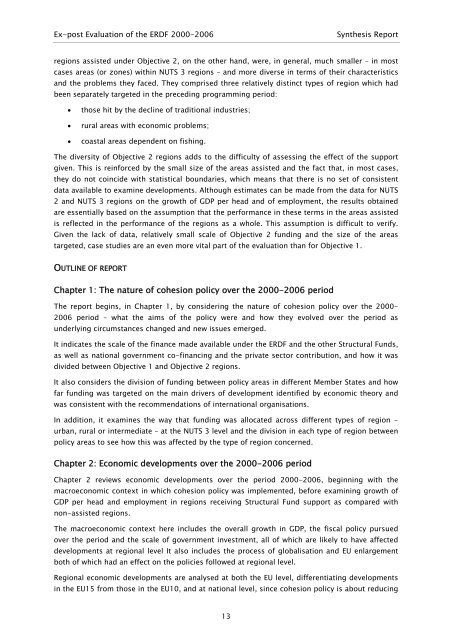Synthesis Report - European Commission - Europa
Synthesis Report - European Commission - Europa
Synthesis Report - European Commission - Europa
Create successful ePaper yourself
Turn your PDF publications into a flip-book with our unique Google optimized e-Paper software.
Ex-post Evaluation of the ERDF 2000-2006<br />
<strong>Synthesis</strong> <strong>Report</strong><br />
regions assisted under Objective 2, on the other hand, were, in general, much smaller – in most<br />
cases areas (or zones) within NUTS 3 regions – and more diverse in terms of their characteristics<br />
and the problems they faced. They comprised three relatively distinct types of region which had<br />
been separately targeted in the preceding programming period:<br />
• those hit by the decline of traditional industries;<br />
• rural areas with economic problems;<br />
• coastal areas dependent on fishing.<br />
The diversity of Objective 2 regions adds to the difficulty of assessing the effect of the support<br />
given. This is reinforced by the small size of the areas assisted and the fact that, in most cases,<br />
they do not coincide with statistical boundaries, which means that there is no set of consistent<br />
data available to examine developments. Although estimates can be made from the data for NUTS<br />
2 and NUTS 3 regions on the growth of GDP per head and of employment, the results obtained<br />
are essentially based on the assumption that the performance in these terms in the areas assisted<br />
is reflected in the performance of the regions as a whole. This assumption is difficult to verify.<br />
Given the lack of data, relatively small scale of Objective 2 funding and the size of the areas<br />
targeted, case studies are an even more vital part of the evaluation than for Objective 1.<br />
OUTLINE OF REPORT<br />
Chapter 1: The nature of cohesion policy over the 2000-2006 period<br />
The report begins, in Chapter 1, by considering the nature of cohesion policy over the 2000-<br />
2006 period – what the aims of the policy were and how they evolved over the period as<br />
underlying circumstances changed and new issues emerged.<br />
It indicates the scale of the finance made available under the ERDF and the other Structural Funds,<br />
as well as national government co-financing and the private sector contribution, and how it was<br />
divided between Objective 1 and Objective 2 regions.<br />
It also considers the division of funding between policy areas in different Member States and how<br />
far funding was targeted on the main drivers of development identified by economic theory and<br />
was consistent with the recommendations of international organisations.<br />
In addition, it examines the way that funding was allocated across different types of region -<br />
urban, rural or intermediate – at the NUTS 3 level and the division in each type of region between<br />
policy areas to see how this was affected by the type of region concerned.<br />
Chapter 2: Economic developments over the 2000-2006 period<br />
Chapter 2 reviews economic developments over the period 2000-2006, beginning with the<br />
macroeconomic context in which cohesion policy was implemented, before examining growth of<br />
GDP per head and employment in regions receiving Structural Fund support as compared with<br />
non-assisted regions.<br />
The macroeconomic context here includes the overall growth in GDP, the fiscal policy pursued<br />
over the period and the scale of government investment, all of which are likely to have affected<br />
developments at regional level It also includes the process of globalisation and EU enlargement<br />
both of which had an effect on the policies followed at regional level.<br />
Regional economic developments are analysed at both the EU level, differentiating developments<br />
in the EU15 from those in the EU10, and at national level, since cohesion policy is about reducing<br />
13

















